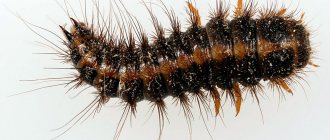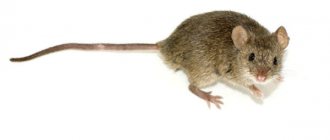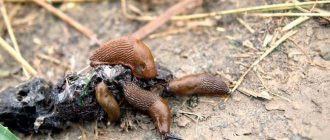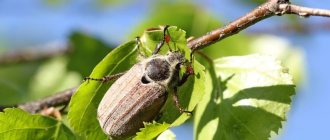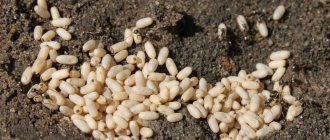With the onset of spring, while digging up beds and plowing the garden, they begin to pay attention to all the strange larvae that can cause harm to seeds, seedlings, roots, and the green part of the plant. One of the most common pests in the garden is the mole cricket, the cockchafer or the beetle. What is the difference between the larvae of the cockchafer and the mole cricket in the photo is demonstrated on different sites. But gardeners continue to invent fables, attributing non-existent features.
Insect larvae
Mole cricket larvae: what are their features
Mole cricket larvae begin active life with the arrival of real spring warmth. They overwinter, buried to a depth of about 2 meters or in dung heaps. The closer it gets warm, the higher the larvae rise to the surface of the earth. At a ground temperature of about +12 degrees, they already feel very comfortable.
In the month of May, the process of laying eggs begins. It is characterized by the fact that sexually mature individuals emerge from their hiding places at night to the surface of the earth and go in search of sexual partners. After mating, the female is busy making a nest for herself. At a depth of about 5 centimeters below the surface of the soil, it digs many underground passages. The main nest is located at a depth of no more than 20 cm.
The female lays at least 400 eggs, which ensures the necessary level of survival of the species. The development of eggs and the birth of mole cricket larvae occur under certain conditions. This requires high humidity, high temperature and air access.
It is important to know! The larva of the mole cricket has fundamental differences compared to the larva of the cockchafer. It is quite easy to identify pests by external signs. The larvae of this pest prefer heaps with manure, while within their nest they destroy plants that block access to sunlight to the nest. May beetle larvae prefer to be in well-groomed areas of the garden.
Fighting mole crickets in the garden
The first and most famous garden pest is the mole cricket - a fairly large insect that leads a mainly underground lifestyle.
Since I started gardening, I have almost thoroughly studied the habits of the common mole cricket. At first I didn’t want to believe that she was on my site, then there was a phase of despair and wild horror, from the fact that I met her nose to nose and was finally convinced that it was she—a bear! Now - I just know that it exists, and let it live, you can’t argue with nature. The disappearance of one species entails other, sometimes unpredictable consequences.
The common mole cricket is widespread throughout the European part of Russia. The natural habitats of the mole cricket are the banks of rivers and streams. She prefers moist, loose soil. In her gardens she prefers planting cabbage, compost heaps, and manure, especially horse manure.
Its presence on the site can be determined not only by cut plants. At the end of May - beginning of June, especially after watering in the morning, winding, dug-up areas of soil are clearly visible in the beds. These are the surface passages of the mole cricket. It is difficult to predict where it will crawl tomorrow. Running after her with a ladle of some nasty stuff is also not fun. Some gardeners sit at night, watch when the mole cricket comes to the surface in order to destroy it. Some gardeners buried three-liter jars of water in the path of mole crickets so that they would fall in and not be able to get out. I remember how I laughed when I read somewhere that you can fight mole crickets if you drive aspen stakes throughout the garden.
I tried planting seedlings in cut-off plastic bottles. But she refused it. The tomatoes have grown well, but the cabbage grew very poorly in these cut-off bottles. While weeding, slightly touching the edges of the bottles, my cabbages flew out of the ground. There was no way they could catch the edge of the root in the ground.
In order not to increase the number of mole crickets in a particular area, I advise you to get rid of boards and logs buried or lying on the ground. Also make sure that the water containers do not leak. Try not to bring manure from unknown places where there may be a concentration of mole crickets. If you just need to purchase, loosen the row spacing more often, try not to put it on the ground, isolate it from the ground so that the mole crickets do not crawl around the garden. Prepare a special container. In such a container you can spill all the humus or manure with pest control drugs. Also isolate compost heaps from contact with the ground.
What to do with the beds where the mole cricket operates? At the beginning of summer, in June, the mole cricket looks for a warm, sunny place to build a nest and lay eggs. The nest protrudes somewhat from the ground and resembles an ordinary hummock. The only unusual thing is that nothing grows next to this hummock within a radius of 20-30 cm. It is around its nest that the mole cricket cuts down all the grass or other plants so that they do not shade the nest. The mole cricket often comes to its nest and checks if everything is in order. Having destroyed the hummock-nest, you can see many gray-yellow eggs slightly smaller than a pea. This is the clutch of a mole cricket . This is exactly how my meeting with the mole cricket happened: I was looking at a clutch of eggs, and she also came to visit them. My legs were paralyzed from horror and numbness, and when she saw me, she quietly began to back away, covering herself with her claw. How scary she is! The only thing I want is to never meet her again.
So, in order to successfully fight mole crickets, you need to loosen the soil more often and do not neglect deep autumn and spring digging. You can plant marigolds, they say that they also scare away the mole cricket from the main plantings of cabbage or potatoes.
One of the effective ways to combat mole crickets is the insecticide preparations Medvetox, Thunder or another drug designed to combat mole crickets and available for sale in your city. It must be used according to the instructions. I’ll tell you right away that it helps. In addition, when planting seedlings, I add crushed eggshells to the holes, which I collect all year.
I also read that you can sprinkle sawdust around the perimeter of the bed and deepen it a little. But I haven’t done it myself, so I can’t recommend it.
My helpers in the fight against mole crickets are cats. As soon as we started living with two cats and a female cat, I noticed that all my plants stayed in place. In the summer, my cats generally catch everything that moves: flies, butterflies, grasshoppers, crickets, caterpillars.
And if the mole cricket moves to the trees, good luck: let it continue to roam the expanses of its native area, improving soil aeration.
If the mole cricket really annoys you, then in the fall, when everything is cleared from the garden and frosts have already begun on the soil, dig several holes up to 50 cm deep, cover it with film and put manure in it. These are traps into which mole crickets must crawl for the winter. Check the holes every morning, at this time mole crickets are slow and easy to destroy. In my opinion, this is the most realistic way to fight mole crickets.
Mole cricket larva: description of appearance
Of course, experienced gardeners can easily distinguish the larvae of these common pests of gardens and vegetable gardens, which cannot be said about novice gardeners. Mole cricket eggs, the number of which can reach 500 pieces, have a length of 1 to 3 mm, and are distinguished by a brownish-reddish tint. The development of larvae occurs over 2 weeks. If conditions are favorable enough, then less than 2 weeks is possible.
At the initial stages, the larvae resemble their family rather than caterpillars. Moreover, they are distinguished by their reddish color. In the initial stages of long-term development, they feed on the shell and saliva of their mother. After one week they molt for the first time, after which the larva increases in size. Moreover, the appearance of the larvae is completely similar to the adult individuals.
The full development cycle until the appearance of an adult takes about 2 years, and sometimes a little less. The last stage is characterized by the appearance of reproductive organs in the larva. During the entire period of development, the larva molts about 10 times, and each time it increases in size and becomes more and more similar to an adult.
It is important to know! The appearance of the larva has a certain resemblance to the adult. The development cycle does not include the caterpillar, pupa, and, especially, the butterfly stages. The development cycle is characterized by the fact that the body of the larva increases from 3 mm to 5 centimeters. Moreover, the size of adult individuals is even larger, about 12 cm.
May beetle larva
The larva of the May beetle has no external resemblance to the larva of the mole cricket, and also differs from it in stages of development.
The breeding season occurs in spring, when the birch tree begins to become covered with its first green leaves. In the month of May, with the arrival of stable warmth, the female burrows to a depth of 1 meter. After this, she lays a large number of white, almost transparent eggs.
It is important to know! The mole cricket almost never lays eggs at a significant depth, since normal development of the eggs requires warmth and access to fresh air. Therefore, a mole cricket’s nest can be found at a depth of up to 50 centimeters, digging deep into the garden.
After about 20 days, the larvae of the cockchafer are born, which are thick, white caterpillars with clearly defined rings. The larvae gradually grow and develop, increasing in size and rising closer to the surface of the earth, eating the root system of plants. The full development cycle of the larva of this insect takes several years.
Interesting fact! Mole cricket larvae begin to destroy cultivated plants almost immediately after birth, which cannot be said about the larvae of the cockchafer. The larvae of the cockchafer are not so voracious and much more harmless.
As the cockchafer larva grows, it becomes similar to a fat worm, yellowish in color. The head is brown in color and has no eyes, but the beetle has a well-developed mouthparts. The front part has three pairs of legs. Its body is translucent, so food debris can be seen in the intestines. On the sides where the rings are located, you can see brown spots. Similar features of the body structure of the cockchafer larva significantly distinguish it from the mole cricket larva.
Mole cricket larvae, May beetle larvae and bronze beetle Differences
How many insects are there on Earth?
The number of insect species is so great that no other class of animals can even come close to it in number. Number of insects in 1 square. m of moistened soil ranges from 1000 to 2000, and many insects are even indistinguishable to the human eye.
Many insects and their larvae are successfully used in fishing, serving as bait. Such insects include caddis flies, bloodworms, mayflies, dragonflies, stoneflies and caterpillars of other different types of butterflies, bark beetles, chafers, maggots and many others. The larva is one of the phases of the insect's life cycle.
Main differences
There are a number of differences that help determine what kind of living creature a given larva represents. For example:
- The mole cricket larva does not go through the worm and pupa stage, so it is born as a fully formed brown pest, although over time the color becomes darker. It takes about 2 years for the pest to develop. At the last stage, wings and genitals appear.
- The cockchafer larva is a white caterpillar with clearly visible rings. Gradually increasing in size, the caterpillar grows up to 6 cm in length and seems to curl into a ring. The larva has 3 pairs of legs that grow in the front of the body. The head is brown in color and has a well-developed mouthparts. The main differences need to be known, since many beetles have similar larvae, but they do not harm agricultural crops.
Important point! The larva of the cockchafer develops in the ground for 3 years, and for the first 2 years it does not pose a particular threat to plants. In the 3rd year of its development, it becomes such a voracious creature that it eats everything that comes in its way.
If there are few larvae of both the May beetle and the mole cricket, then they are not able to cause much harm to garden plantings. But if there are a lot of them, then it can turn into a real disaster.
Winter armyworm and methods of combating it
The fall armyworm is a nocturnal moth. I call her: a big fat moth. The butterfly itself is not as dangerous as its caterpillar - thick, large, gray, but can also be light brown. It depends on the type of cutworm, because there are a huge number of them - for almost every plant there is a corresponding type of cutworm. On the ground, the caterpillar is difficult to see. The color matches the top layer of soil.
The fall armyworm caterpillar is a major agricultural pest. She does not disdain anything, she is practically omnivorous. The caterpillar can damage cereals, potatoes, beets, onions, garlic, corn, tomatoes, cucumbers, okra, and cabbage. During the daytime, caterpillars can hide from sunlight under plant leaves or in the top layer of soil, and at night they crawl out to hunt.
The damage caused by the fall armyworm caterpillar is similar to the damage caused by the mole cricket. By the way, I saw a trimmed onion that had fallen off. I thought that the bear had come out. I raked the soil around the gnawed onion and saw a gray caterpillar. This is the winter armyworm caterpillar. Just like the mole cricket, it cuts off young plants at soil level or simply gnaws the petioles of leaves, gnaws out entire hollows in potatoes, Jerusalem artichoke, beets, carrots and other root vegetables.
The fall armyworm caterpillar is capable of destroying seeds and seedlings in the soil, causing the seedlings to be very sparse and bald spots to appear in continuous plantings. Caterpillars of the first generation fall armyworm damage our gardens, damaging vegetable crops in June - July. The second generation caterpillars “specialize” in sowing winter crops. How to deal with the winter armyworm ?
The main and effective measure to combat the fall armyworm is deep digging of the soil in autumn and spring to a depth of 25-27 cm , which destroys the pupae and caterpillars of the winter armyworm.
At the beginning of summer, when vegetable crops have already been planted, loosen the rows more often. When damaged plants appear, rake the top layer of soil - you will probably find a thick gray caterpillar. Therefore, careful loosening of row spacing can be considered one of the methods of combating winter armyworm caterpillars.
Try to keep an eye on more than just your garden beds. Constantly mow roadsides and the area around your property. Flowering weeds are a source of food and egg-laying for the fall armyworm butterflies.
Traps with fermenting drinks : compote, beer, kvass are effective against the moth
Insecticides can be used against fall armyworm caterpillars: Decis, Bazudin, Arrivo, Sherpa. Moreover, these drugs can be effectively used in the following mixture - half the consumption rate of insecticides according to the instructions and 100-120 g of urea per 10 liters of water.
Preventive actions
You can protect your site from the invasion of voracious creatures in a fairly simple way, by digging deep into the site 2 times a year. Using this method, it is possible to destroy nests, as well as destroy larvae that are in the last stage of development.
Anyone who uses regular manure as fertilizer should know that it is best to apply it in the fall. Once scattered around the garden, in the spring there will be no living mole cricket eggs left, as they will die from frost. When manure is applied in the spring, a person infects his plot with his own hands.
There are other ways to protect your area from these parasites. For example, planting beds with garlic, as well as using garlic cloves when planting garden crops, can significantly reduce the scale of infection of the area. Flower beds with marigolds, chrysanthemums, calendula, etc. have the same effect.
Pest control in the garden plot should be comprehensive. Here it is very important to combine various methods of control, including the use of chemistry. Often, traditional recipes do not help to completely get rid of pests, so insecticides have to be used. Chemicals not only quickly destroy pests, but are also able to protect the area from them for a long time.
Are there methods of prevention?
It is easier to prevent any problem than to correct the consequences later. This also applies to pest control. To avoid the appearance of such uninvited guests, you should adhere to certain rules:
- The depth of digging the soil should not be less than 40 cm.
- If you find larvae in the soil, be sure to collect them.
- Get chickens and let them out into the garden for a walk in the spring. They also feed on chafer larvae. As a last resort, hang birdhouses for starlings.
- At the beginning of autumn, be sure to dig up the soil and then treat it with a weak chlorine solution.
- In the spring, treat the soil near the roots of strawberry bushes with ammonia solution. When preparing the drug, follow the proportions. For 10 liters of water, 20 ml of ammonia is required.
- Mulching the soil helps a lot. To do this, you can use crushed wood and shavings. Such materials do not allow insects to penetrate into the soil.
- You can make grooves between the plants by filling them with Karbofos solution (0.75).
Compliance with preventive measures will preserve the harvest and prevent the proliferation of pests in the garden. The main thing is to follow the instructions.

